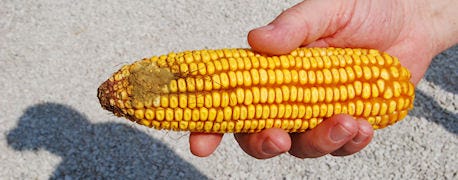September 7, 2012

Early harvest reports confirm the presence of aflatoxin in corn in some fields in several areas of Iowa. In the following article Charles Hurburgh and Chad Hart explain what farmers need to know about making a claim to their crop insurance company. Hurburgh is a grain quality expert in Iowa State University's Department of Ag and Biosystems Engineering. Hart is an ISU Extension grain marketing economist.

SCOUT FIELDS: Pull back husks on several ears of each hybrid and look for signs of Aspergillus ear rot. This green mold usually shows up on kernels at tip of the ear first, especially if they've been damaged. If you find Aspergillus fungus, that still doesn't mean Aflatoxin was produced, but the grain should be tested.
Farmers urged to leave field check strips for crop insurance
Farmers who have aflatoxin or drought-reduced yields or other crop damage in their fields this fall should leave check strips of unharvested corn for crop insurance purposes. The standing strips are critical to verify crop insurance claims.
Aflatoxin is covered under multiperil crop insurance. The settlement is done as a deducted percentage of actual yield depending on the aflatoxin level.
If a claim is made, the aflatoxin level will be determined in the field, before the grain is harvested and put in storage. A crop insurance adjuster will either hand-harvest ears from predetermined representative locations in the field or collect samples at harvest from trucks/wagons. Strips may be left for later harvest or hand sampling, at the direction of the adjuster. Hot weather conditions can cause the aflatoxin levels in strips to increase beyond harvest levels.
Testing must be done by a lab approved by insurance company
An elevator or processor can also be approved to collect and combine samples for submission to a lab, if the corn is marketed from the field. Testing must be done by lab approved by the insurance carrier, generally a disinterested third party capable of accurate mycotoxin testing.
~~~PAGE_BREAK_HERE~~~A list of labs, including the USDA-GIPSA agencies serving Iowa, is at www.iowagrain.org. The Risk Management Agency has posted a fact sheet on aflatoxin testing for insurance purposes. Aflatoxin levels must be above 20 parts per billion before insurance payments are impacted.
Elevators and processors typically are not approved to do crop insurance testing for aflatoxin. Complete USDA-RMA loss adjustment procedures are available. This includes sections on the adjustment of aflatoxin losses. Speak with your insurance carrier for specific instructions.
You must call your crop insurance agent before you harvest
Remember these important points: 1) Your crop insurance agent must be called before you harvest the corn; no settlements will be made for corn already in storage; 2) producers getting a crop insurance settlement for aflatoxin must direct the corn to an approved use for the level present, with documentation of test results; 3) All measurements, samples and testing must be done under supervision of the adjuster. Aflatoxin is an adulterant under the federal Food and Drug Law, with specific provisions on how it should be handled, depending on determined level.
For a photo of Aspergillus ear rot and more information, go to www.extension.iastate.edu/CropNews/2012/0801robertson.htm
Summing up: Here are several other things to keep in mind regarding aflatoxin and crop insurance
• Accurate analysis for aflatoxin is difficult because of sampling error when getting a representative sample of the grain.
• Accurate analysis requires large samples of grain to be fully ground for testing.
• Black light screening of the corn grain can be very useful if a strict protocol is followed.
• A scale-up testing process can help optimize testing programs to levels required by specific markets.
• The best sample of any large lot is one containing portions of every sublot.
• Marketing corn with known levels of aflatoxin in excess of the 20 parts per billion action level requires clear documentation.
• Aflatoxin is covered by multiperil crop insurance with specific stipulations regarding adjustment and marketing.
For farm management information and analysis go to ISU's Ag Decision Maker site www.extension.iastate.edu/agdm and Extension farm management specialist Steve Johnson's site www.extension.iastate.edu/polk/farmmanagement.htm.
You May Also Like




